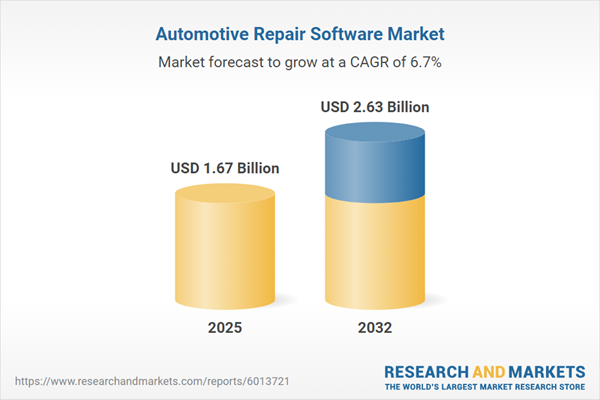Speak directly to the analyst to clarify any post sales queries you may have.
The automotive repair software market is rapidly evolving as organizations prioritize digitization to strengthen core operations and better address dynamic client and industry requirements. Executives must proactively adapt technology strategies to maintain efficiency and achieve differentiation in this changing sector.
Market Snapshot: Growth & Digital Adoption in the Automotive Repair Software Market
The automotive repair software market is set for robust, steady growth, projected to rise from USD 1.57 billion in 2024 to USD 1.67 billion in 2025 with a CAGR of 6.67%. By 2032, market value is expected to near USD 2.63 billion. This momentum results from repair shops, auto dealerships, and fleet operators investing in digital modernization to enhance diagnostics, workflow efficiency, and customer service standards. As software becomes fundamental to aftersales operations, senior leaders are emphasizing technology strategies that foster agility, internal alignment, and improved service quality across every touchpoint.
Scope & Segmentation: Comprehensive Market Coverage
- Application Types: Solutions offer billing, accounting, customer relationship management, inventory control, shop management, and vehicle diagnostics, each engineered to minimize errors and increase productivity across service operations.
- Deployment Modes: Cloud, hybrid, private cloud, public cloud, and on-premise models enable organizations to match software setup with governance needs and IT preferences, ensuring compliance and scalability as digital priorities evolve.
- End Users: The landscape serves auto dealerships, fleet operators, independent repair shops, and specialty repair shops, allowing customization to fit unique workflow and technology needs.
- Vehicle Types: Platforms support heavy commercial vehicles, light commercial vehicles, and passenger cars, giving maintenance providers an edge across all major fleet and vehicle categories.
- Organization Sizes: Solutions address the needs of large, medium, and small enterprises, scaling digital transformation initiatives according to existing digital maturity and readiness for further innovation.
- Distribution Channels: Vendors reach customers via channel partners and direct sales, giving buyers flexibility to select sourcing models that align with changing purchasing trends and organizational needs.
- Geographic Regions: Key regions include the Americas, Europe, Middle East & Africa, and Asia-Pacific, with offerings tailored to comply with local regulations, diverse market maturity levels, and customer preferences.
- Leading Companies Profiled: Featured providers such as CDK Global, Inc., Reynolds and Reynolds Co., Cox Automotive, Inc., CCC Intelligent Solutions Inc., Mitchell International, Inc., Solera Holdings, Inc., Tekmetric, Inc., Shop-Ware, Inc., AutoFluent, Inc., and R.O. Writer, Inc. are spotlighted for their roles in driving innovation and shaping market practices.
Key Takeaways for Senior Decision Makers
- Digital transformation is now central to optimizing aftersales operations, with software adoption pivotal for organizational resilience and elevating service benchmarks.
- Flexible deployment options, including cloud and hybrid models, ensure seamless operation across distributed teams while allowing quick adaptation as business or compliance demands shift.
- Integration of artificial intelligence, IoT connectivity, and mobile diagnostic tools supports predictive maintenance, enabling more proactive decision-making by management teams.
- Customization and configuration of solutions must address the distinct operational goals of diverse market segments, ensuring that technology investments yield measurable value for each user group.
- Increasing cooperation among software vendors, OEM partners, and telematics specialists propels the ecosystem forward, boosting innovation and continuous improvement in connected workflows.
- Regional disparities persist, with mature markets focusing on advanced analytics and integration, while emerging areas prioritize adaptive solutions for their unique operational and compliance needs.
Tariff Impact: Navigating Policy-Driven Disruption
Forthcoming United States tariffs anticipated in 2025 are prompting automotive software buyers to revisit procurement strategies. Escalating hardware and analytics costs are pushing many organizations to migrate to cloud-hosted platforms, reducing capital outlay and offering greater insulation from sudden policy changes. In response, suppliers are updating their licensing and procurement models to help clients sustain uninterrupted service delivery, even during regulatory volatility and fluctuating cost structures.
Methodology & Data Sources
This assessment is informed by direct executive interviews and secondary research from industry publications, regulatory materials, SWOT analysis, and Porter’s Five Forces to deliver substantiated, actionable guidance for automotive sector leaders.
Why This Report Matters to Automotive Technology Leaders
- Empowers executives with clear perspective on digital strategies, regulatory shifts, and evolving operational priorities to facilitate forward-thinking business decisions.
- Enables organizations to clarify investment areas and sharpen competitive positioning, supporting more robust planning at both organizational and regional scales.
- Delivers real-time intelligence on procurement opportunities, partnership planning, and digital security to enhance leadership confidence in technology adoption.
Conclusion
Applying these insights helps automotive technology leaders stay agile, strategically invest in future-ready platforms, and maintain superior performance in a dynamic digital environment.
Additional Product Information:
- Purchase of this report includes 1 year online access with quarterly updates.
- This report can be updated on request. Please contact our Customer Experience team using the Ask a Question widget on our website.
Table of Contents
3. Executive Summary
4. Market Overview
7. Cumulative Impact of Artificial Intelligence 2025
Companies Mentioned
The companies profiled in this Automotive Repair Software market report include:- CDK Global, Inc.
- Reynolds and Reynolds Co.
- Cox Automotive, Inc.
- CCC Intelligent Solutions Inc.
- Mitchell International, Inc.
- Solera Holdings, Inc.
- Tekmetric, Inc.
- Shop-Ware, Inc.
- AutoFluent, Inc.
- R.O. Writer, Inc.
Table Information
| Report Attribute | Details |
|---|---|
| No. of Pages | 180 |
| Published | November 2025 |
| Forecast Period | 2025 - 2032 |
| Estimated Market Value ( USD | $ 1.67 Billion |
| Forecasted Market Value ( USD | $ 2.63 Billion |
| Compound Annual Growth Rate | 6.6% |
| Regions Covered | Global |
| No. of Companies Mentioned | 11 |









